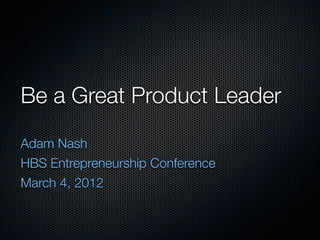
Be a Great Product Leader (HBS ICE 2012)
- 1. Be a Great Product Leader Adam Nash HBS Entrepreneurship Conference March 4, 2012
- 2. Optimus Prime “Fate rarely calls upon us at a moment of our choosing”
- 3. Full Circle: World-Class Product Original meeting with Reid Hoffman turned in a four hour conversation on what world class product meant in a Web 2.0 world (circa 2007). Most people start or join new companies because they think “we can do it better this time”. They come to build a company. These are the top lessons I’ve personally gained over the past decade about product management for the modern consumer web.
- 4. Bottoms Up, Not Top Down It’s ironic, but most people who make their living building distributed systems revert to centralized control when it comes to organizations. In an incredibly detailed & fast-paced market, the people closest to the metrics & issue are best suited to make both tactical and strategic calls. Management responsibility is a combination of harmonizing the definition of success, traffic control, and portfolio allocation. 1
- 5. Optimize Around Talent Our most important asset is our people. The key is not just to attract and retain the best talent, but also to set up organization and process where they can do their best work. There can be endless philosophical and political debates possible about organization and process. Example: Web Development 2
- 6. Put People Directly on High Priority Goals (or Problems) This may sound obvious, but it continues to be very rare in practice. Diffuse responsibility is a killer. It’s an expensive solution, but when you’ve identified the few goals that matter, it’s exactly the right answer. A small, cross-functional team, free to execute with clear, direct goals and authority is an incredibly powerful force. Example: Growth 3
- 7. What Do We Demand of Product Managers? Strategy How do we win the game, and how do we keep score? Prioritization What are the steps from here to there, and what order do we do them in? Execution For this phase, what’s the list of what has to get done, and are we on track? 4
- 8. Product: Results Matter In the end, we judge product managers by whether they “win games” The role itself can give limited authority. Like a new coach, the team will let you define the plays initially. But in the end, you have to show the team wins. Product leaders don’t play the game, but they are judged by the record of their products. They cover any gaps. No excuses. Responsibility, often without authority 5
- 9. Prioritization: Three Buckets Metrics Movers These pay the bills. In the end, software that doesn’t justify itself will lose the ability to fund itself. Customer Requests If you don’t listen to customers, they will lose faith in you and eventually hate you. Delight If you don’t delight customers, you won’t inspire passion and loyalty in your users. 6
- 10. Can’t I Have All Three? It’s not impossible, but it’s extremely rare. Very often, metrics movers are not requested or delightful. Very often, customer requests will not move your metrics or delight people. Very often, delight features will not move your metrics, and by definition, are not requested. Great products, however, combine all three. In agile processes, releases intersperse all three regularly. 6
- 11. Understanding Virality One of the key insights of our growth strategy from 2008. Extensible to literally all engagement features. Key measure used by applications on social platforms. This is an extremely useful frame. Two questions: what features let members touch non members? How does a new customer today lead to a new customer tomorrow? At the heart of virality is an exponential based on branching factor and time. In an m^n equation, m is the branching factor, n is the cycles in a time period. Rabbits make lots of rabbits not because of big litters, but because they breed frequently. “n” matters more than “m”. 7
- 12. Engagement Can Be Measured Believe it or not, this issue has been hotly debated Key metrics include: MAU / Total User Base DAU / MAU PV / DAU Don’t be afraid to learn from startups and/or competitors. You are not always a unique snowflake. 8
- 13. Find the Heat There are two sides to boosting engagement: lowering the friction of reaching out, and increasing the desire to engage. It’s easy to focus on the first and ignore the second, but social software depends on capturing the real nuances of human interaction. Heat is a placeholder term for emotions that drive action, both positive and negative. Ask yourself the hard questions of what strong emotions drive the actions in your products. Examples: Polls 2.0, Apply with LinkedIn 9
- 14. Simple is Hard For some reason, people are talking a lot about Steve Jobs these days. Inevitably this concept comes up. It’s true in design, it’s true in metrics, it’s true in prioritization, and it’s true in strategy. What’s the one thing you want the user to do? What’s the fundamental use case your feature addresses for users? Example: Mobile First design 10
- 15. Final Thoughts We can be our own harshest critics. In the mirror we see every flaw, every mistake, every imperfection. These are the very early years. Things that seem small now can and will be huge in 5 years. Each of you can and will have a profound impact on that future. Behavior matters. Values matter. Be a Great Product Leader.
- 16. Optimus Prime “There’s a thin line between being a hero and being a memory.”
Editor's Notes
- \n
- \n
- \n
- \n
- \n
- \n
- \n
- \n
- \n
- \n
- \n
- \n
- \n
- \n
- \n
- \n
